Sport Participation and Gender Differences in Dietary Preferences: A Cross-Sectional Study in Italian Adults
Abstract
1. Introduction
2. Methods
2.1. Study Design and Participants
2.2. Food Preference Data
2.3. Tools for Assessing and Measuring Physical Activity
2.4. Statistical Analysis
3. Results
4. Discussion
4.1. Association Between Sports Participation and Food Preferences
4.2. Gender-Specific Dietary Patterns Among Sports Participants
4.3. Variation in Food Preferences by Type of Sport
4.4. Age-Related Patterns in Dietary Preferences Among Sports Participants
4.5. Strengths and Limitations
5. Conclusions
Supplementary Materials
Author Contributions
Funding
Institutional Review Board Statement
Data Availability Statement
Acknowledgments
Conflicts of Interest
References
- Durstine, J.L.; Gordon, B.; Wang, Z.; Luo, X. Chronic disease and the link to physical activity. J. Sport Health Sci. 2013, 2, 3–11. [Google Scholar] [CrossRef]
- Miller, K.R.; McClave, S.A.; Jampolis, M.B.; Hurt, R.T.; Krueger, K.; Landes, S.; Collier, B. The Health Benefits of Exercise and Physical Activity. Curr. Nutr. Rep. 2016, 5, 204–212. [Google Scholar] [CrossRef]
- Perrone, M.A.; Feola, A.; Pieri, M.; Donatucci, B.; Salimei, C.; Lombardo, M.; Perrone, A.; Parisi, A. The Effects of Reduced Physical Activity on the Lipid Profile in Patients with High Cardiovascular Risk during COVID-19 Lockdown. Int. J. Environ. Res. Public Health 2021, 18, 8858. [Google Scholar] [CrossRef] [PubMed]
- Martín-Rodríguez, A.; Belinchón-deMiguel, P.; Rubio-Zarapuz, A.; Tornero-Aguilera, J.F.; Martínez-Guardado, I.; Villanueva-Tobaldo, C.V.; Clemente-Suárez, V.J. Advances in Understanding the Interplay between Dietary Practices, Body Composition, and Sports Performance in Athletes. Nutrients 2024, 16, 571. [Google Scholar] [CrossRef] [PubMed] [PubMed Central]
- Amawi, A.; AlKasasbeh, W.; Jaradat, M.; Almasri, A.; Alobaidi, S.; Hammad, A.A.; Bishtawi, T.; Fataftah, B.; Turk, N.; Saoud, H.A.; et al. Athletes’ nutritional demands: A narrative review of nutritional requirements. Front. Nutr. 2024, 10, 1331854. [Google Scholar] [CrossRef] [PubMed] [PubMed Central]
- van der Avoort, C.M.T.; Ten Haaf, D.S.M.; de Vries, J.H.M.; Verdijk, L.B.; van Loon, L.J.C.; Eijsvogels, T.M.H.; Hopman, M.T.E. Higher Levels of Physical Activity Are Associated with Greater Fruit and Vegetable intake in Older Adults. J. Nutr. Health Aging 2021, 25, 230–241. [Google Scholar] [CrossRef]
- Molanorouzi, K.; Khoo, S.; Morris, T. Motives for adult participation in physical activity: Type of activity, age, and gender. BMC Public Health 2015, 15, 66. [Google Scholar] [CrossRef]
- Rankin, A.; Bunting, B.P.; Poínhos, R.; van der Lans, I.A.; Fischer, A.R.; Kuznesof, S.; Almeida, M.; Markovina, J.; Frewer, L.J.; Stewart-Knox, B.J. Food choice motives, attitude towards and intention to adopt personalised nutrition. Public Health Nutr. 2018, 21, 2606–2616. [Google Scholar] [CrossRef] [PubMed] [PubMed Central]
- Fernqvist, F.; Spendrup, S.; Tellström, R. Understanding food choice: A systematic review of reviews. Heliyon 2024, 10, e32492. [Google Scholar] [CrossRef] [PubMed] [PubMed Central]
- Sunderji, S.; Murray, R.M.; Sabiston, C.M. Gender Differences in the Implicit and Explicit Perceptions of Sport. Sex Roles 2024, 90, 1188–1199. [Google Scholar] [CrossRef]
- Lombardo, M.; Feraco, A.; Armani, A.; Camajani, E.; Gorini, S.; Strollo, R.; Padua, E.; Caprio, M.; Bellia, A. Gender differences in body composition, dietary patterns, and physical activity: Insights from a cross-sectional study. Front. Nutr. 2024, 11, 1414217. [Google Scholar] [CrossRef]
- Azevedo, M.; Araújo, C.; Reichert, F.; Siqueira, F.V.; da Silva, M.C.; Hallal, P. Gender differences in leisure-time physical activity. Int. J. Public Health 2007, 52, 8–15. [Google Scholar] [CrossRef]
- Wang, J.; Zhang, S.; Zhang, J.J. Moderating Effects of Gender and Life Cycle in the Relationship between Desired Self-Image and Sport Participation Behavior: A Multi-Group Analysis. Meas. Phys. Educ. Exerc. Sci. 2018, 23, 337–350. [Google Scholar] [CrossRef]
- Feraco, A.; Gorini, S.; Camajani, E.; Filardi, T.; Karav, S.; Cava, E.; Strollo, R.; Padua, E.; Caprio, M.; Armani, A.; et al. Gender differences in dietary patterns and physical activity: An insight with principal component analysis (PCA). J. Transl. 2024, 22, 1112. [Google Scholar] [CrossRef] [PubMed]
- Schulz, C.A.; Oluwagbemigun, K.; Nöthlings, U. Advances in dietary pattern analysis in nutritional epidemiology. Eur. J. Nutr. 2021, 60, 4115–4130. [Google Scholar] [CrossRef] [PubMed] [PubMed Central]
- Hooson Jzh, J.; Hutchinson Jyh, J.; Warthon-Medina, M.; Hancock, N.; Greathead, K.; Knowles, B.; Vargas-Garcia, E.; Gibson, L.E.; Bush, L.A.; Margetts, B.; et al. A systematic review of reviews identifying UK validated dietary assessment tools for inclusion on an interactive guided website for researchers: www.nutritools.org. Crit. Rev. Food Sci. Nutr. 2020, 60, 1265–1289. [Google Scholar] [CrossRef] [PubMed]
- Sarmento, T.C.; Ferreira, R.D.S.; Franco, O.L. Plant-Based Diet and Sports Performance. ACS Omega 2024, 9, 47939–47950. [Google Scholar] [CrossRef] [PubMed] [PubMed Central]
- Soltani, S.; Jayedi, A.; Shab-Bidar, S.; Becerra-Tomás, N.; Salas-Salvadó, J. Adherence to the Mediterranean Diet in Relation to All-Cause Mortality: A Systematic Review and Dose-Response Meta-Analysis of Prospective Cohort Studies. Adv. Nutr. 2019, 10, 1029–1039. [Google Scholar] [CrossRef]
- Feng, H.; Yang, L.; Liang, Y.Y.; Ai, S.; Liu, Y.; Liu, Y.; Jin, X.; Lei, B.; Wang, J.; Zheng, N.; et al. Associations of timing of physical activity with all-cause and cause-specific mortality in a prospective cohort study. Nat. Commun. 2023, 14, 930. [Google Scholar] [CrossRef]
- Carey, C.C.; Creedon, E.M.; Molloy, F.; Lewis, M.; Smith, B.L.; McCarthy, E.K. Exploring Food Choice Influences in Athletes and Active Populations in Ireland: A Cross-Sectional Study. Curr. Dev. Nutr. 2025, 9, 104568. [Google Scholar] [CrossRef]
- Craddock, J.C.; Neale, E.P.; Peoples, G.E.; Probst, Y.C. Examining dietary behaviours, diet quality, motives and supplementation use in physically active individuals following vegetarian-based eating patterns. Nutr. Bull. 2022, 4, 473–487. [Google Scholar] [CrossRef] [PubMed] [PubMed Central]
- Aryannezhad, S.; Mok, A.; Imamura, F.; Wareham, N.J.; Brage, S.; Forouhi, N.G. Combined associations of physical activity, diet quality and their changes over time with mortality: Findings from the EPIC-Norfolk study, United Kingdom. BMC Med. 2024, 22, 464. [Google Scholar] [CrossRef] [PubMed] [PubMed Central]
- Roy, B.D. Milk: The new sports drink? A Review. J. Int. Soc. Sports Nutr. 2008, 5, 15. [Google Scholar] [CrossRef] [PubMed]
- Alcantara, J.M.A.; Sanchez-Delgado, G.; Martinez-Tellez, B.; Labayen, I.; Ruiz, J.R. Impact of cow’s milk intake on exercise performance and recovery of muscle function: A systematic review. J. Int. Soc. Sports Nutr. 2019, 16, 22. [Google Scholar] [CrossRef] [PubMed]
- Cavalli-Sforza, L.T.; Strata, A.; Barone, A.; Cucurachi, L. Primary adult lactose malabsorption in Italy: Regional differences in prevalence and relationship to lactose intolerance and milk consumption. Am. J. Clin. Nutr. 1987, 45, 748–754. [Google Scholar] [CrossRef]
- Rozin, P.; Hormes, J.M.; Faith, M.S.; Wansink, B. Is Meat Male? A Quantitative Multimethod Framework to Establish Metaphoric Relationships. J. Consum. Res. 2012, 39, 629–643. [Google Scholar] [CrossRef]
- Rosenfeld, D.L.; Tomiyama, A.J. Gender differences in meat consumption and openness to vegetarianism. Appetite 2021, 166, 105475. [Google Scholar] [CrossRef]
- Bärebring, L.; Palmqvist, M.; Winkvist, A.; Augustin, H. Gender differences in perceived food healthiness and food avoidance in a Swedish population-based survey: A cross sectional study. Nutr. J. 2020, 19, 140. [Google Scholar] [CrossRef]
- Oude Groeniger, J.; Kamphuis, C.B.M.; Mackenbach, J.P.; Beenackers, M.A.; van Lenthe, F.J. Are socio-economic inequalities in diet and physical activity a matter of social distinction? A cross-sectional study. Int. J. Public Health 2019, 64, 1037–1047. [Google Scholar] [CrossRef] [PubMed] [PubMed Central]
- Rogerson, D. Vegan diets: Practical advice for athletes and exercisers. J. Int. Soc. Sports Nutr. 2017, 14, 36. [Google Scholar] [CrossRef]
- Helms, E.R.; Prnjak, K.; Linardon, J. Towards a Sustainable Nutrition Paradigm in Physique Sport: A Narrative Review. Sports 2019, 7, 172. [Google Scholar] [CrossRef]
- van der Horst, H.; Sällylä, A.; Michielsen, Y. Game changers for meat and masculinity? Male athletes’ perspectives on mixed and plant-based diets. Appetite 2023, 187, 106585. [Google Scholar] [CrossRef]
- Roberts, B.M.; Helms, E.R.; Trexler, E.T.; Fitschen, P.J. Nutritional Recommendations for Physique Athletes. J. Hum. Kinet. 2020, 71, 79–108. [Google Scholar] [CrossRef] [PubMed] [PubMed Central]
- Devrim-Lanpir, A.; Hill, L.; Knechtle, B. Efficacy of Popular Diets Applied by Endurance Athletes on Sports Performance: Beneficial or Detrimental? A Narrative Review. Nutrients 2021, 13, 491. [Google Scholar] [CrossRef] [PubMed] [PubMed Central]
- Hilkens, L.; Cruyff, M.; Woertman, L.; Benjamins, J.; Evers, C. Social Media, Body Image and Resistance Training: Creating the Perfect ‘Me’ with Dietary Supplements, Anabolic Steroids and SARM’s. Sports Med. Open 2021, 7, 81. [Google Scholar] [CrossRef] [PubMed]
- Money-Taylor, E.; Dobbin, N.; Gregg, R.; Matthews, J.J.; Esen, O. Differences in attitudes, behaviours and beliefs towards eating between female bodybuilding athletes and non-athletes, and the implications for eating disorders and disordered eating. Sport Sci. Health 2022, 18, 67–74. [Google Scholar] [CrossRef]
- Arora, S.; Kataria, P.; Nautiyal, M.; Tuteja, I.; Sharma, V.; Ahmad, F.; Haque, S.; Shahwan, M.; Capanoglu, E.; Vashishth, R.; et al. Comprehensive Review on the Role of Plant Protein as a Possible Meat Analogue: Framing the Future of Meat. ACS Omega 2023, 8, 23305–23319. [Google Scholar] [CrossRef] [PubMed] [PubMed Central]
- Huiberts, R.O.; Wüst, R.C.I.; van der Zwaard, S. Concurrent Strength and Endurance Training: A Systematic Review and Meta-Analysis on the Impact of Sex and Training Status. Sports Med. 2024, 54, 485–503. [Google Scholar] [CrossRef] [PubMed] [PubMed Central]
- Committee on Examination of the Adequacy of Food Resources and SNAP Allotments; Food and Nutrition Board; Committee on National Statistics; Institute of Medicine; National Research Council; Caswell, J.A.; Yaktine, A.L. (Eds.) Individual, Household, and Environmental Factors Affecting Food Choices and Access. In Supplemental Nutrition Assistance Program: Examining the Evidence to Define Benefit Adequacy; National Academies Press: Washington, DC, USA, 2013. Available online: https://www.ncbi.nlm.nih.gov/books/NBK206912/ (accessed on 15 June 2025).
- Jimenez-Morcillo, J.; Clemente-Suárez, V.J. Gender Differences in Body Satisfaction Perception: The Role of Nutritional Habits, Psychological Traits, and Physical Activity in a Strength-Training Population. Nutrients 2024, 16, 104. [Google Scholar] [CrossRef]
- West, S.; Monteyne, A.J.; van der Heijden, I.; Stephens, F.B.; Wall, B.T. Nutritional Considerations for the Vegan Athlete. Adv. Nutr. 2023, 14, 774–795. [Google Scholar] [CrossRef] [PubMed] [PubMed Central]
- Wollmar, M.; Post, A.; Sjöberg, A. Food choice, activity level, and carbon footprint: Exploring potential for sustainable food consumption practices in young adults. Front. Nutr. 2024, 11, 1449054. [Google Scholar] [CrossRef]
- Wickramasinghe, K.; Mathers, J.C.; Wopereis, S.; Marsman, D.S.; Griffiths, J.C. From lifespan to healthspan: The role of nutrition in healthy ageing. J. Nutr. Sci. 2020, 9, e33. [Google Scholar] [CrossRef] [PubMed] [PubMed Central]
- Moradell, A.; Casajús, J.A.; Moreno, L.A.; Vicente-Rodríguez, G.; Gómez-Cabello, A. Effects of Diet-Exercise Interaction on Human Health across a Lifespan. Nutrients 2023, 15, 2520. [Google Scholar] [CrossRef] [PubMed] [PubMed Central]
- Escoto, K.H.; Laska, M.N.; Larson, N.; Neumark-Sztainer, D.; Hannan, P.J. Work hours and perceived time barriers to healthful eating among young adults. Am. J. Health Behav. 2012, 36, 786–796. [Google Scholar] [CrossRef] [PubMed] [PubMed Central]
- Tessier, A.J.; Wang, F.; Korat, A.A.; Eliassen, A.H.; Chavarro, J.; Grodstein, F.; Li, J.; Liang, L.; Willett, W.C.; Sun, Q.; et al. Optimal dietary patterns for healthy aging. Nat. Med. 2025, 31, 1644–1652. [Google Scholar] [CrossRef]
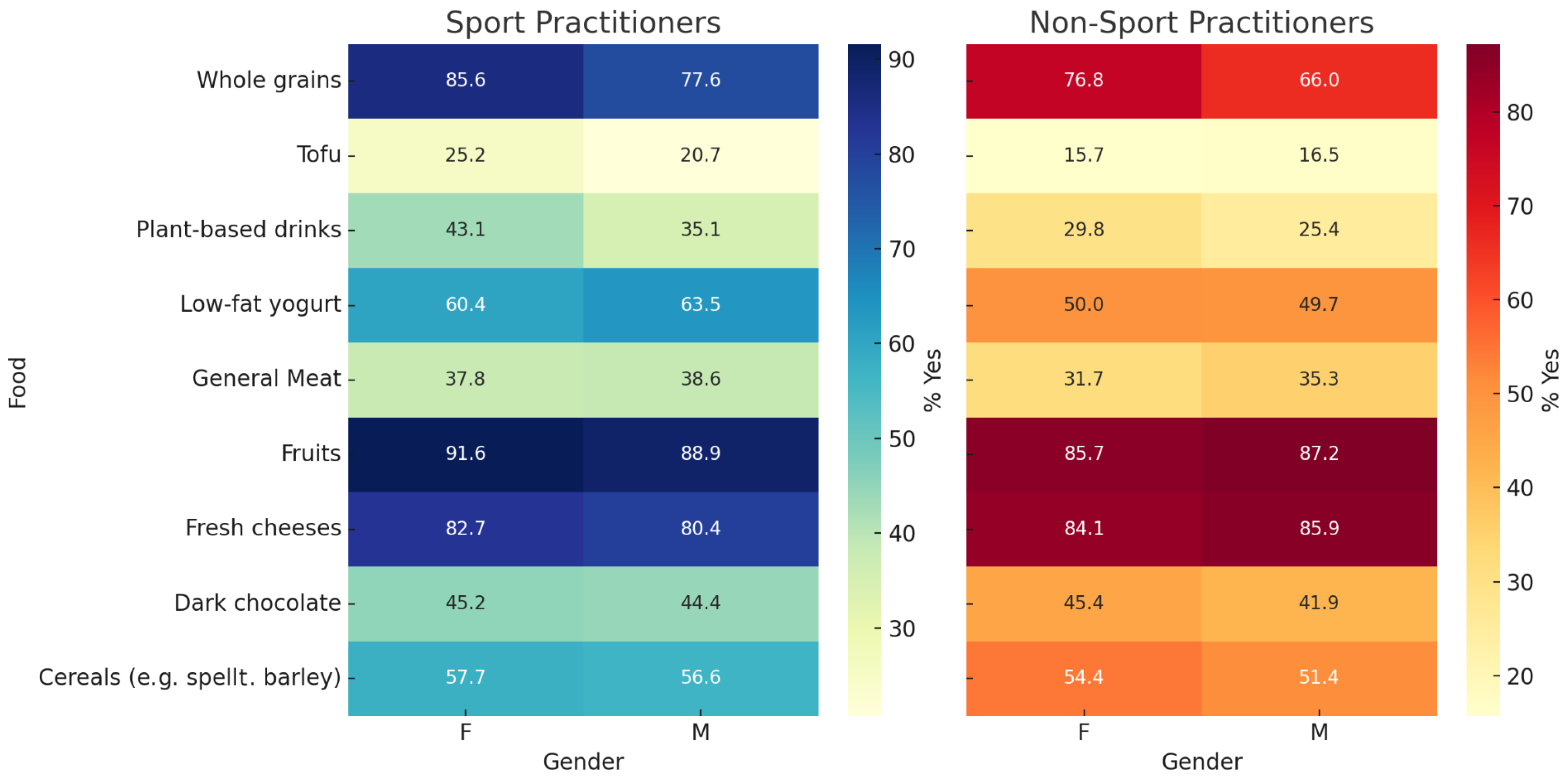
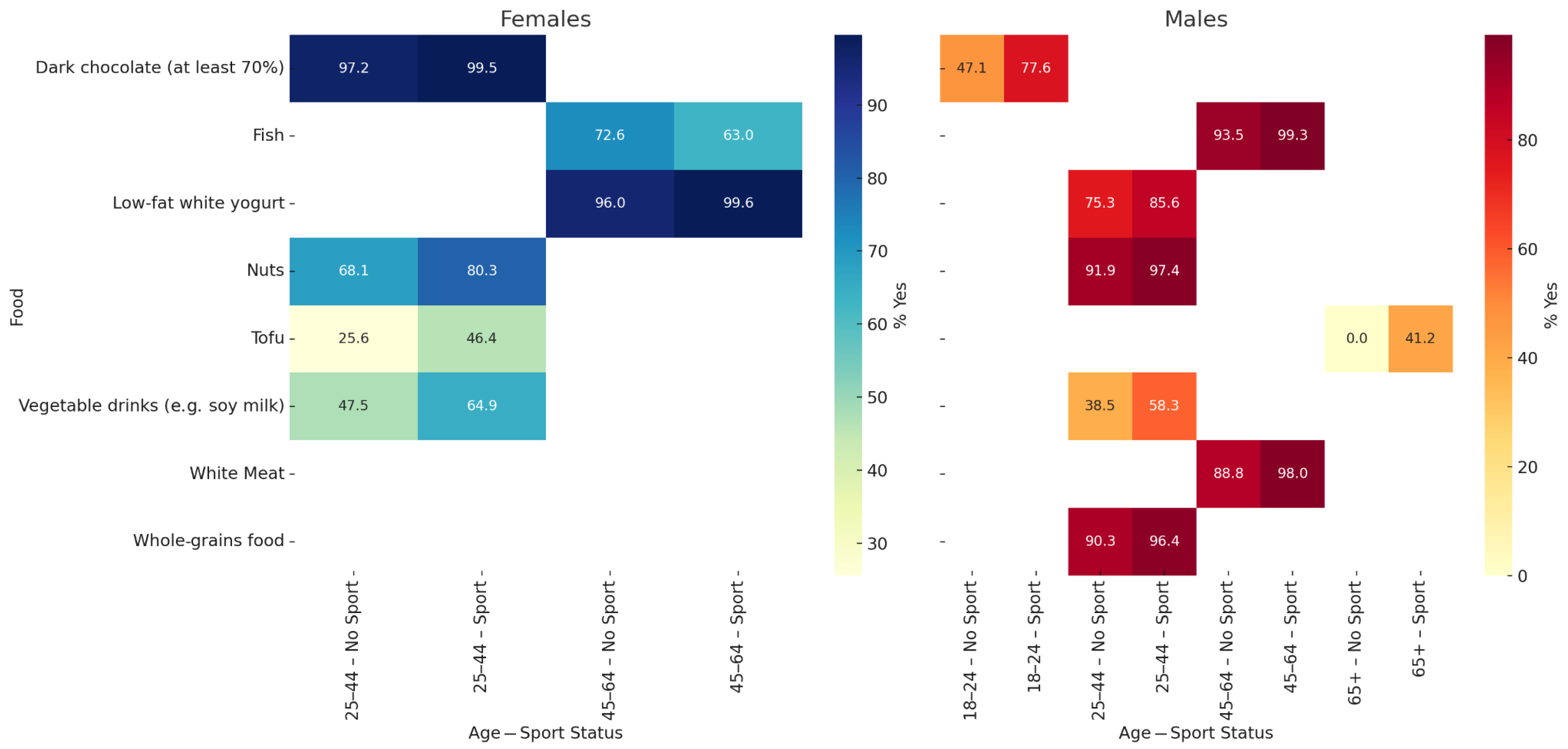
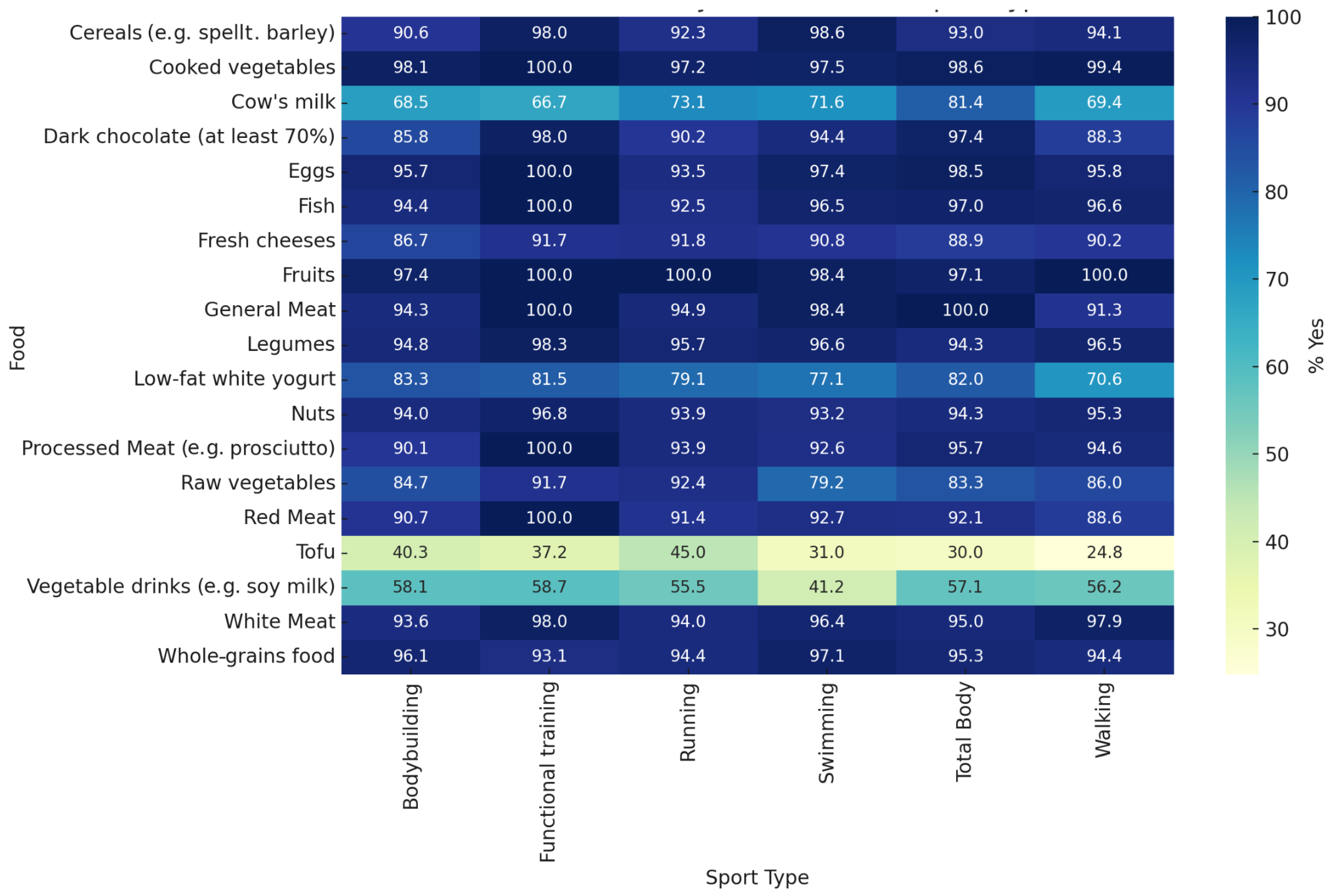
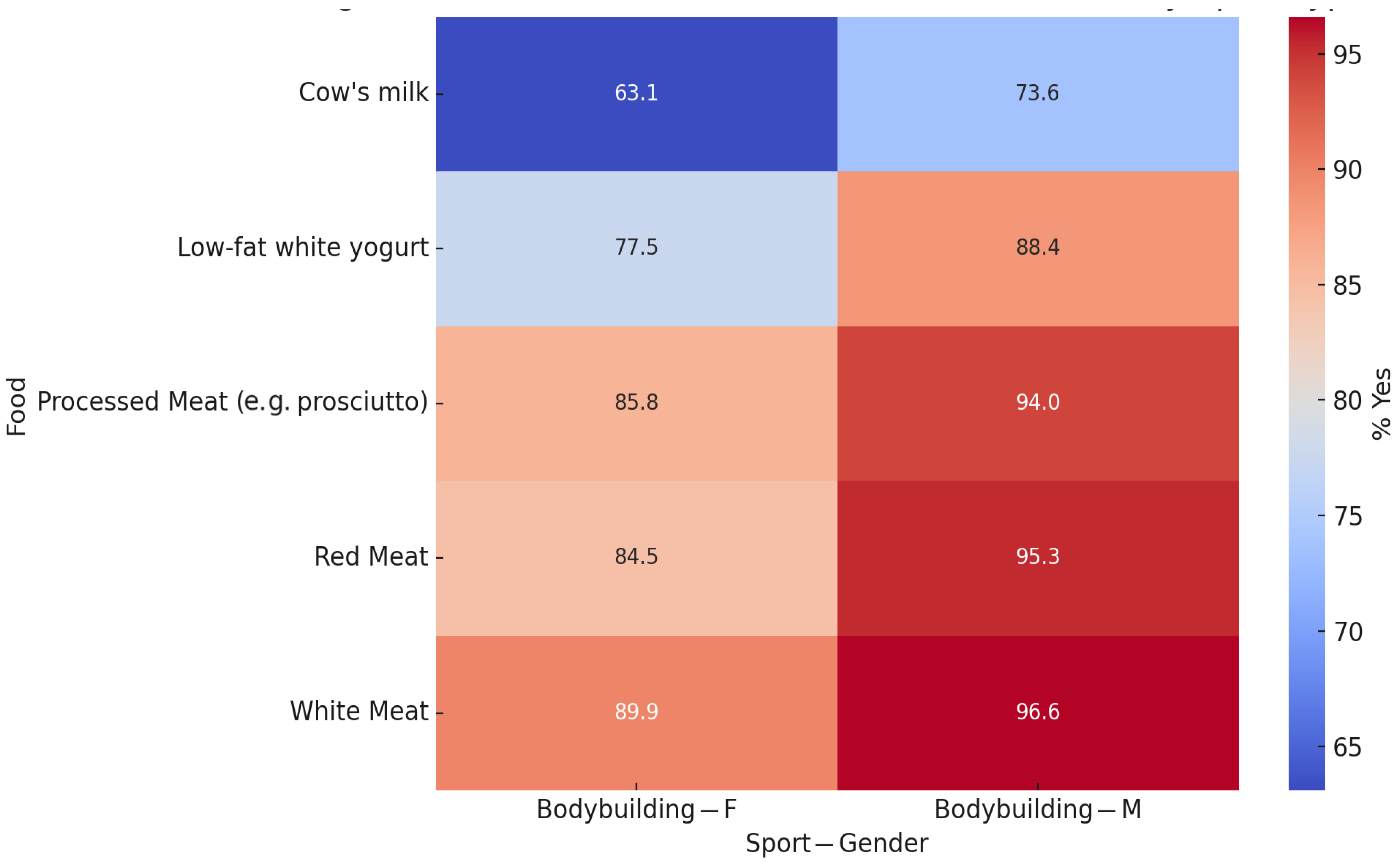
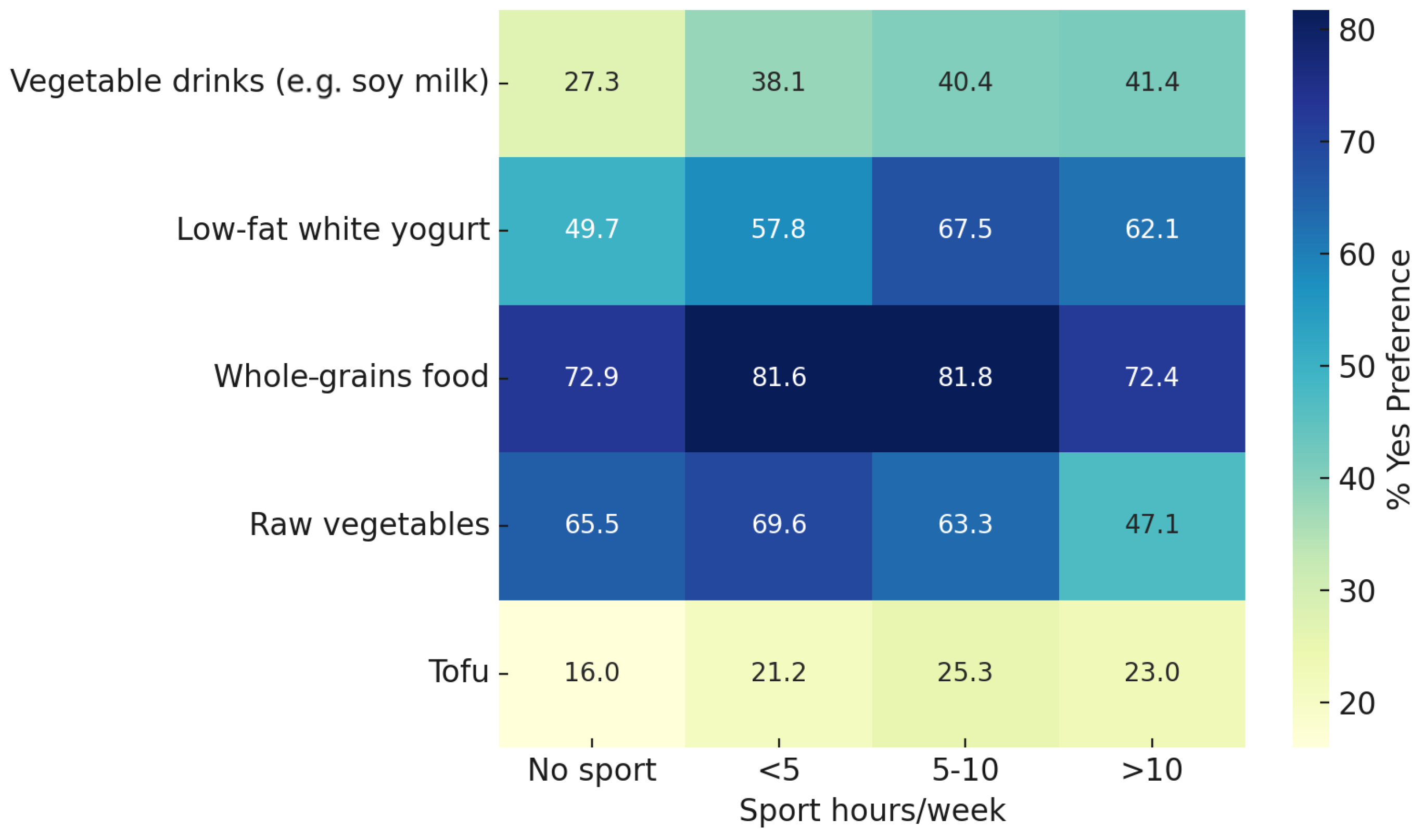
| Total (n) | M | F | p-Value | |||
|---|---|---|---|---|---|---|
| Subjects | n | 2665 | 1090 | 1575 | – | |
| Smokers | yes | 23.9% | 23.3% | 24.4% | 0.5173 | |
| Age | Age | yrs | 40.8 ± 13.3 | 39.5 ± 13.2 | 41.6 ± 13.4 | <0.0001 |
| 18–24 | % | 11.3% | 13.5% | 9.8% | 0.0043 | |
| 25–44 | 51.3% | 53.8% | 49.5% | 0.0347 | ||
| 45–64 | 32.2% | 28.3% | 34.9% | 0.0003 | ||
| 65+ | 5.2% | 4.5% | 5.7% | 0.1927 | ||
| INCOME PER YEAR | <EUR 20,000 | % | 16.1% | 13.7% | 17.7% | 0.0061 |
| EUR 20,000—EUR 40,000 | 67.8% | 69.0% | 67.0% | 0.2947 | ||
| EUR 40,000–EUR 60,000 | 13.1% | 14.2% | 12.3% | 0.1548 | ||
| >EUR 60,000 | 2.8% | 2.9% | 2.7% | 0.8443 | ||
| No participation in sport | % | 46.4% | 39.9% | 50.9% | <0.0001 | |
| Participation in sport | 53.5% | 60.1% | 49.0% | <0.0001 | ||
| Bodybuilding | % | 19.1% | 25.5% | 14.7% | <0.0001 | |
| Running | 7.0% | 9.9% | 5.0% | 0.0012 | ||
| Walking | 6.3% | 4.4% | 7.7% | <0.0001 | ||
| Swimming | 4.5% | 5.9% | 3.5% | 0.1245 | ||
| Total body | 3.5% | 2.5% | 4.1% | 0.0010 | ||
| Functional training | 2.7% | 3.2% | 2.3% | 0.7269 | ||
| Variable | % | Total (n = 1415) | Males (n = 655) | Females (n = 760) | p-value | |
| <5 h/week sport | % | 49.7 | 44.9 | 53.8 | <0.0001 | |
| 5–10 h/week sport | % | 38.4 | 42.2 | 35.2 | ||
| >10 h/week sport | % | 11.9 | 12.9 | 11.0 | ||
| Most frequent time of day for sport | Total (n = 1355) | Males (n = 621) | Females (n = 734) | p-value | ||
| Before Breakfast | % | 6.7 | 7.3 | 6.2 | 0.4955 | |
| After breakfast | % | 9.3 | 8.2 | 10.2 | ||
| During the morning | % | 17.1 | 15.9 | 18.1 | ||
| In the afternoon | % | 25.1 | 26.4 | 24 | ||
| Before dinner | % | 35.4 | 35.7 | 35.1 | ||
| After dinner | % | 2.2 | 2.4 | 1.9 |
| Food Item | β | SE | 95% CI (β) | OR | 95% CI (OR) | p-Value |
|---|---|---|---|---|---|---|
| Cow’s milk | −0.19 | 0.08 | −0.35, −0.03 | 0.82 | 0.70, 0.97 | 0.018 |
| Vegetable drinks (e.g., soy milk) | 0.45 | 0.08 | 0.28, 0.61 | 1.56 | 1.33, 1.84 | <0.001 |
| Low-fat white yogurt | 0.42 | 0.08 | 0.27, 0.58 | 1.53 | 1.31, 1.79 | <0.001 |
| Fresh cheeses | −0.06 | 0.11 | −0.27, 0.15 | 0.94 | 0.76, 1.16 | 0.570 |
| General meat | 0.29 | 0.18 | −0.05, 0.63 | 1.34 | 0.95, 1.89 | 0.097 |
| White meat | 0.16 | 0.15 | −0.14, 0.45 | 1.17 | 0.87, 1.57 | 0.293 |
| Red meat | −0.05 | 0.13 | −0.31, 0.20 | 0.95 | 0.74, 1.22 | 0.687 |
| Processed meat | −0.08 | 0.12 | −0.32, 0.15 | 0.92 | 0.73, 1.16 | 0.485 |
| Fish | 0.28 | 0.10 | 0.08, 0.49 | 1.33 | 1.08, 1.63 | 0.006 |
| Eggs | 0.08 | 0.12 | −0.15, 0.31 | 1.08 | 0.86, 1.36 | 0.498 |
| Legumes | −0.16 | 0.21 | −0.58, 0.26 | 0.85 | 0.56, 1.29 | 0.454 |
| Cooked vegetables | 0.93 | 0.30 | 0.34, 1.52 | 2.53 | 1.40, 4.57 | 0.002 |
| Raw vegetables | 0.26 | 0.13 | 0.01, 0.51 | 1.30 | 1.01, 1.66 | 0.039 |
| Fruits | 0.68 | 0.27 | 0.15, 1.22 | 1.98 | 1.16, 3.40 | 0.013 |
| Cereals (e.g., spelt, barley) | 0.21 | 0.18 | −0.14, 0.56 | 1.23 | 0.87, 1.75 | 0.242 |
| Whole-grain foods | 0.67 | 0.18 | 0.32, 1.02 | 1.96 | 1.38, 2.78 | <0.001 |
| Nuts | 0.30 | 0.17 | −0.04, 0.64 | 1.34 | 0.96, 1.89 | 0.089 |
| Tofu | 0.50 | 0.11 | 0.28, 0.71 | 1.64 | 1.33, 2.03 | <0.001 |
| Dark chocolate (≥70%) | 0.46 | 0.16 | 0.13, 0.78 | 1.58 | 1.14, 2.18 | 0.006 |
| β | SE | 95% CI (β) | OR | 95% CI (OR) | p-Value | |
|---|---|---|---|---|---|---|
| Cow’s milk | 0.20 | 0.11 | −0.00, 0.41 | 1.23 | 1.00, 1.51 | 0.053 |
| Vegetable drinks (e.g., soy milk) | −0.28 | 0.11 | −0.49, −0.07 | 0.76 | 0.61, 0.93 | 0.008 |
| Low-fat white yogurt | 0.12 | 0.11 | −0.09, 0.32 | 1.12 | 0.91, 1.38 | 0.274 |
| Fresh cheeses | −0.08 | 0.14 | −0.35, 0.19 | 0.92 | 0.71, 1.21 | 0.558 |
| General meat | 1.27 | 0.29 | 0.69, 1.84 | 3.54 | 2.00, 6.28 | <0.001 |
| White meat | 0.67 | 0.22 | 0.24, 1.09 | 1.95 | 1.27, 2.98 | 0.002 |
| Red meat | 1.15 | 0.20 | 0.77, 1.54 | 3.17 | 2.15, 4.65 | <0.001 |
| Processed meat | 0.72 | 0.17 | 0.40, 1.05 | 2.06 | 1.49, 2.86 | <0.001 |
| Fish | 0.27 | 0.14 | −0.01, 0.54 | 1.31 | 0.99, 1.72 | 0.058 |
| Eggs | 0.63 | 0.16 | 0.31, 0.95 | 1.87 | 1.36, 2.58 | <0.001 |
| Legumes | 0.16 | 0.17 | −0.17, 0.48 | 1.17 | 0.84, 1.61 | 0.341 |
| Cooked vegetables | 0.04 | 0.23 | −0.42, 0.50 | 1.04 | 0.66, 1.65 | 0.868 |
| Raw vegetables | 0.15 | 0.12 | −0.09, 0.39 | 1.16 | 0.91, 1.48 | 0.218 |
| Fruits | 0.09 | 0.13 | −0.17, 0.35 | 1.09 | 0.85, 1.42 | 0.489 |
| Cereals (e.g., spelt, barley) | 0.05 | 0.13 | −0.21, 0.30 | 1.05 | 0.81, 1.35 | 0.702 |
| Whole-grain foods | 0.03 | 0.13 | −0.23, 0.28 | 1.03 | 0.80, 1.33 | 0.831 |
| Nuts | 0.06 | 0.13 | −0.19, 0.31 | 1.07 | 0.83, 1.36 | 0.642 |
| Tofu | 0.16 | 0.13 | −0.09, 0.41 | 1.17 | 0.92, 1.51 | 0.206 |
| Dark chocolate (≥70%) | 0.09 | 0.13 | −0.17, 0.36 | 1.10 | 0.84, 1.43 | 0.480 |
Disclaimer/Publisher’s Note: The statements, opinions and data contained in all publications are solely those of the individual author(s) and contributor(s) and not of MDPI and/or the editor(s). MDPI and/or the editor(s) disclaim responsibility for any injury to people or property resulting from any ideas, methods, instructions or products referred to in the content. |
© 2025 by the authors. Licensee MDPI, Basel, Switzerland. This article is an open access article distributed under the terms and conditions of the Creative Commons Attribution (CC BY) license (https://creativecommons.org/licenses/by/4.0/).
Share and Cite
Campoli, F.; Padua, E.; Panzarino, M.; Caprioli, L.; Annino, G.; Lombardo, M. Sport Participation and Gender Differences in Dietary Preferences: A Cross-Sectional Study in Italian Adults. Sports 2025, 13, 258. https://doi.org/10.3390/sports13080258
Campoli F, Padua E, Panzarino M, Caprioli L, Annino G, Lombardo M. Sport Participation and Gender Differences in Dietary Preferences: A Cross-Sectional Study in Italian Adults. Sports. 2025; 13(8):258. https://doi.org/10.3390/sports13080258
Chicago/Turabian StyleCampoli, Francesca, Elvira Padua, Michele Panzarino, Lucio Caprioli, Giuseppe Annino, and Mauro Lombardo. 2025. "Sport Participation and Gender Differences in Dietary Preferences: A Cross-Sectional Study in Italian Adults" Sports 13, no. 8: 258. https://doi.org/10.3390/sports13080258
APA StyleCampoli, F., Padua, E., Panzarino, M., Caprioli, L., Annino, G., & Lombardo, M. (2025). Sport Participation and Gender Differences in Dietary Preferences: A Cross-Sectional Study in Italian Adults. Sports, 13(8), 258. https://doi.org/10.3390/sports13080258









